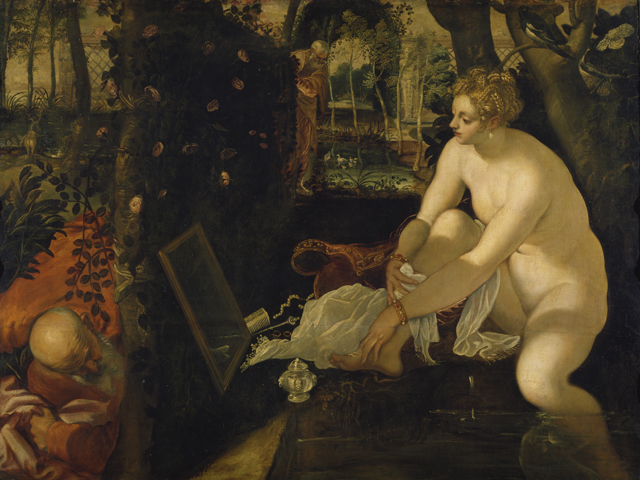Fr : version française / En: english version
mheu, Historical Museum of the Urban Environment
Susanna at her Bath
Jacopo Robusti, called Tintoretto

1555
oil on canvas
146cm x 193.6cm
Vienna, Kunsthistorisches Museum
© Photobusiness - ARTOTHEK
View this work in the exhibition Bathing
The work
In this other version on the same theme of Susanna at her Bath, Tintoretto links the gazes of the two elders by the line of perspective provided by the hedge. The mirror, which reflects nothing except a scrap of white material, is placed between them. And the water in the fountain, which plays the same part as the mirror in the Louvre painting, apart from its limpid transparency, shows nothing other than the reflection of the stones. The story is the same, only the scene is different. But this time we have understood. We do not try to look for Susanna's secrets in the river where they are not to be seen. And that is a pity, because although Susanna's reflection is not there, the painting is there, splendid, imposing, breathtaking.
The artist
The young Jacopo's father, Battista Robusti, was a dyer (tintore) and his son was nicknamed Tintoretto. He was born in Venice in 1518. Some historians believe he was taught by Titian while others claim Boniface de Pitabi. Whichever was the case, in his youth he was influenced by the former before breaking away and adopting a mannerist style verging on baroque, both dynamic and turbulent, with dramatic lighting.
In 1564, he was appointed decorator of the Scuola Grande di San Rocco in Venice, for which he painted a total of sixty-seven pictures, the last in 1588. Well-known throughout Italy and invited to the Gonzaga court in Mantua in 1578, Tintoretto painted quickly, often after having studied the light using wax models of the scenes and figures he was to paint, which gave his work its dramatic aspect. He died in Venice in 1594.